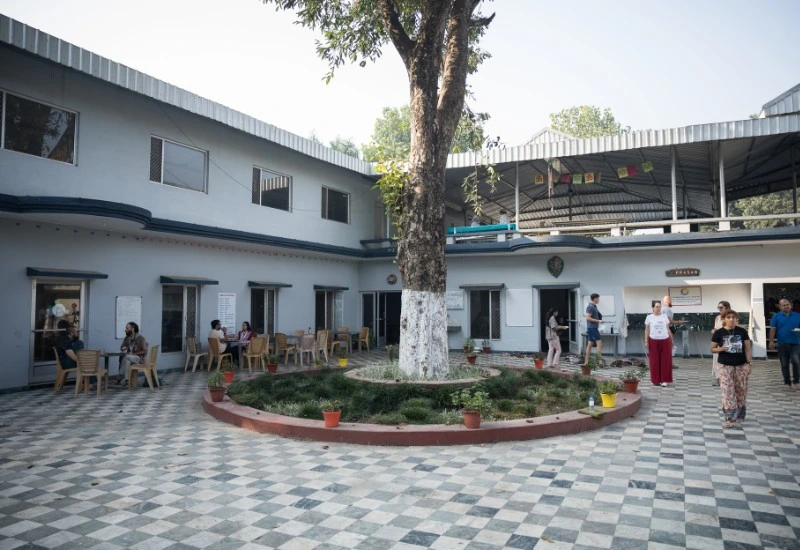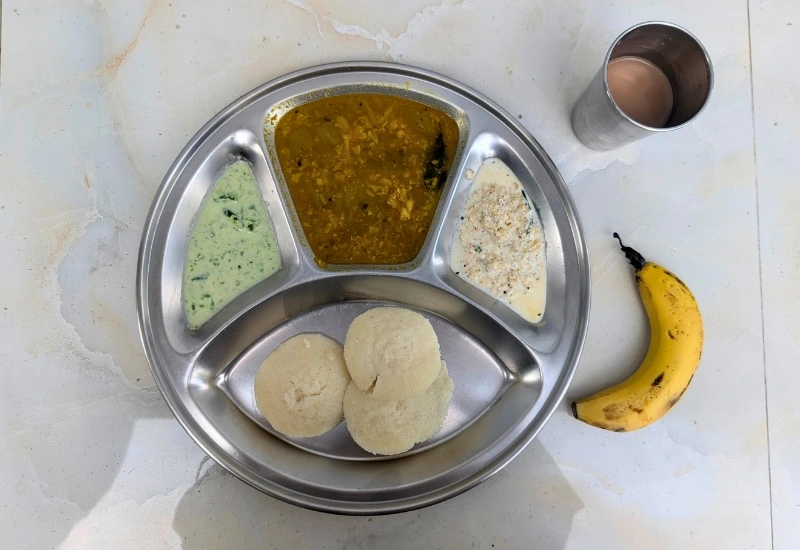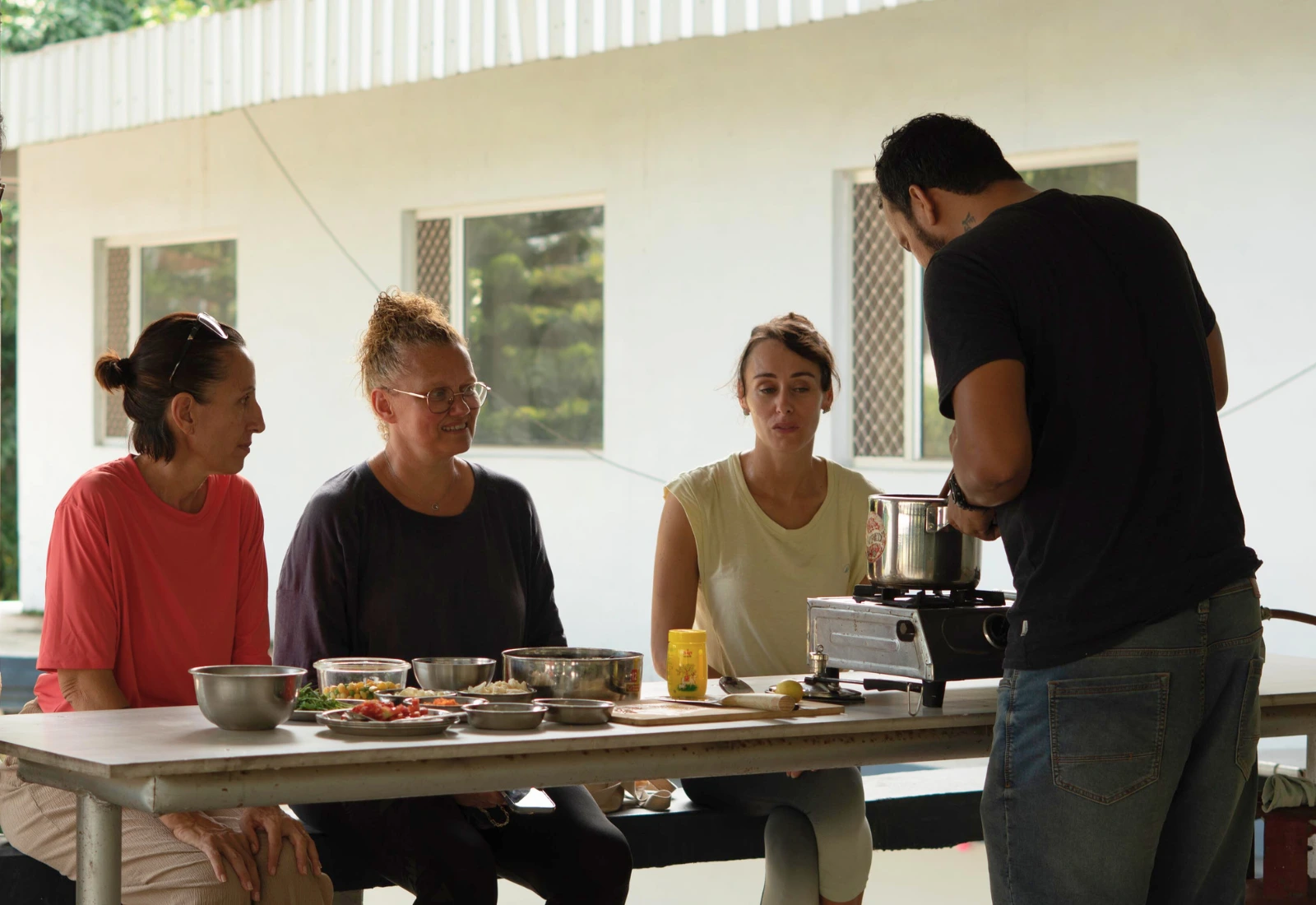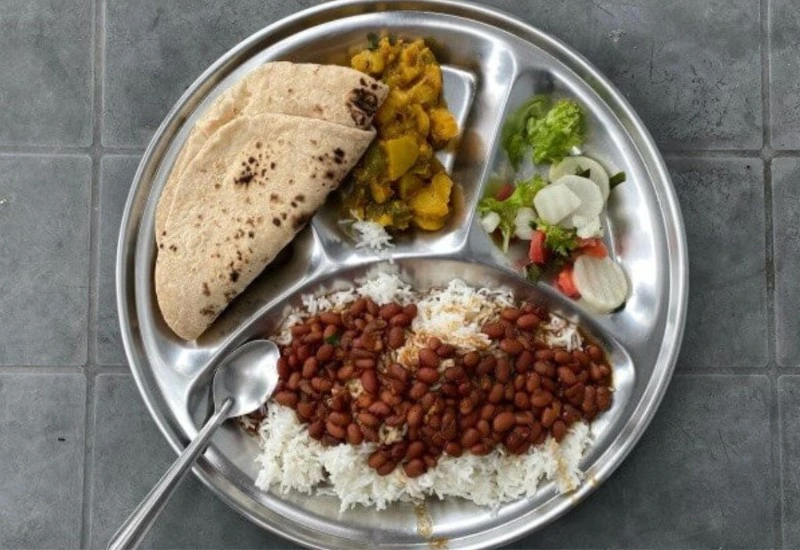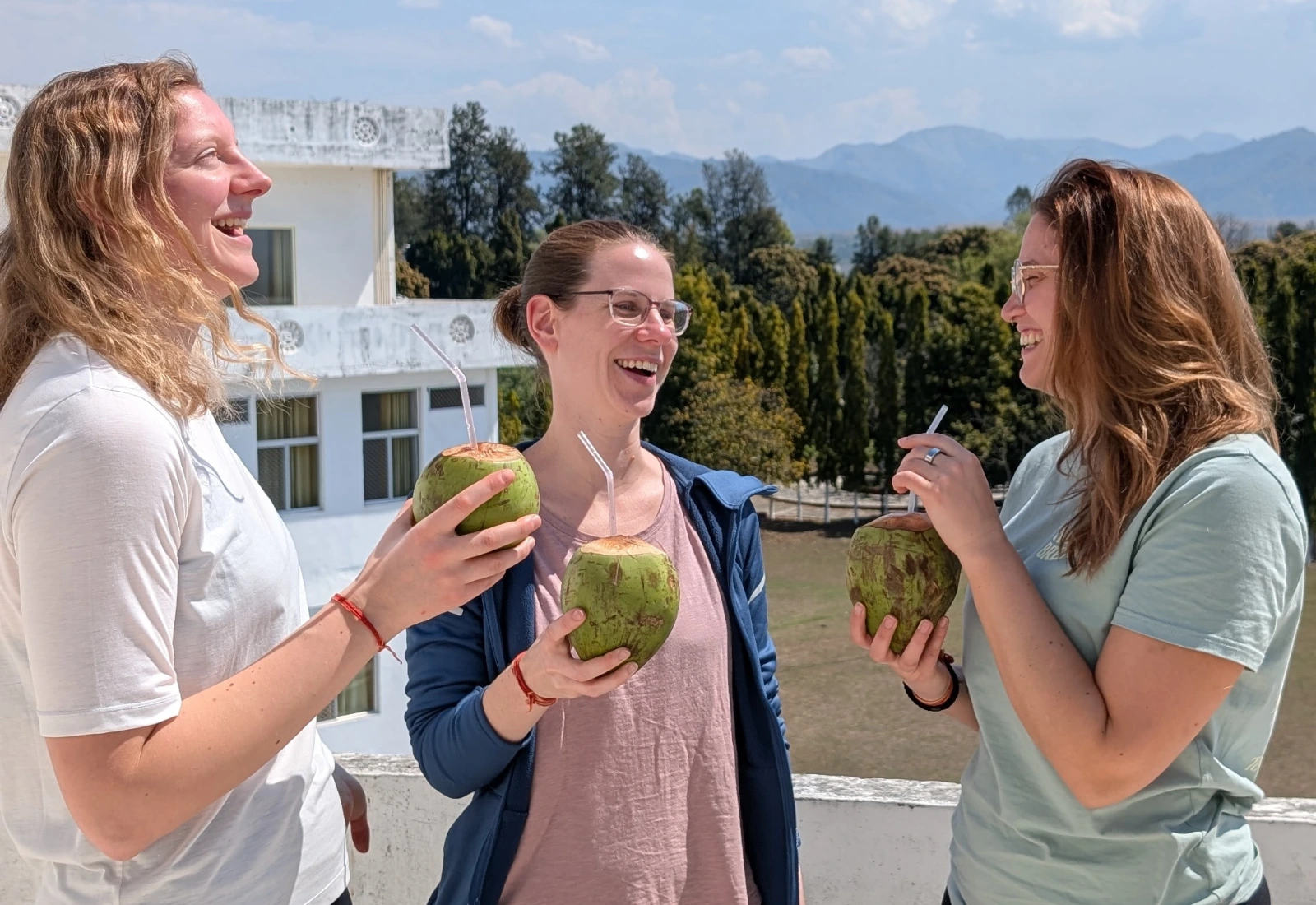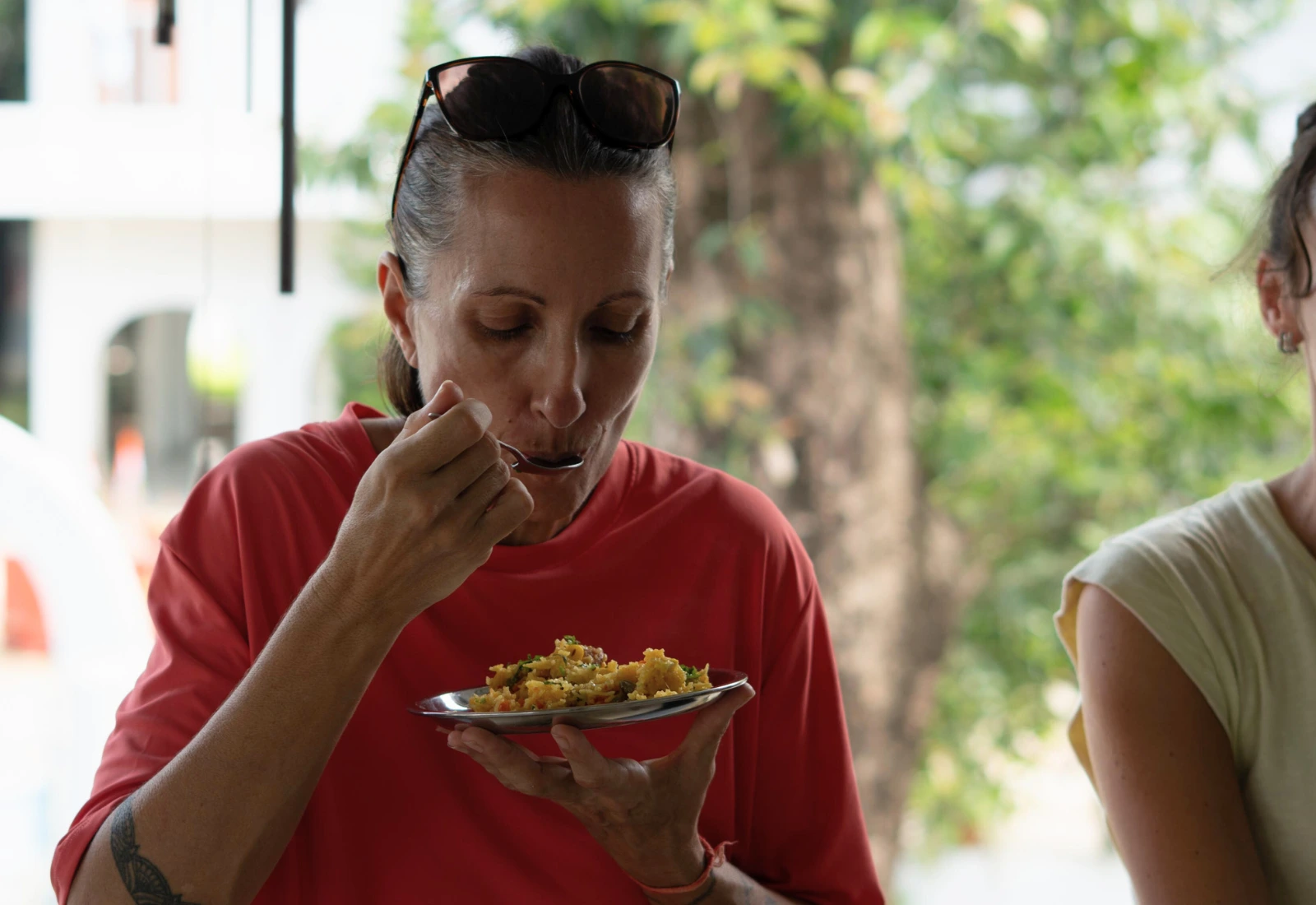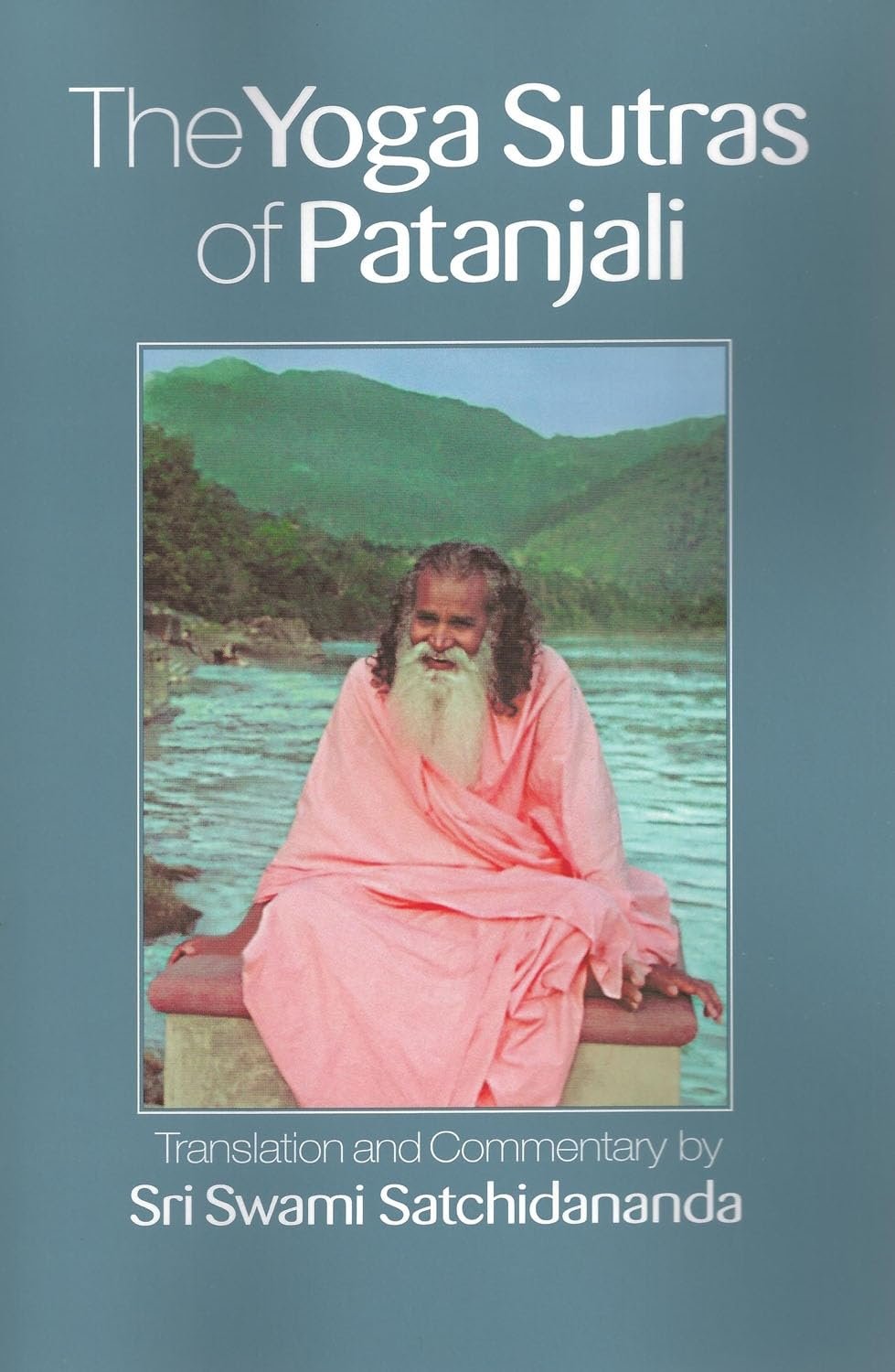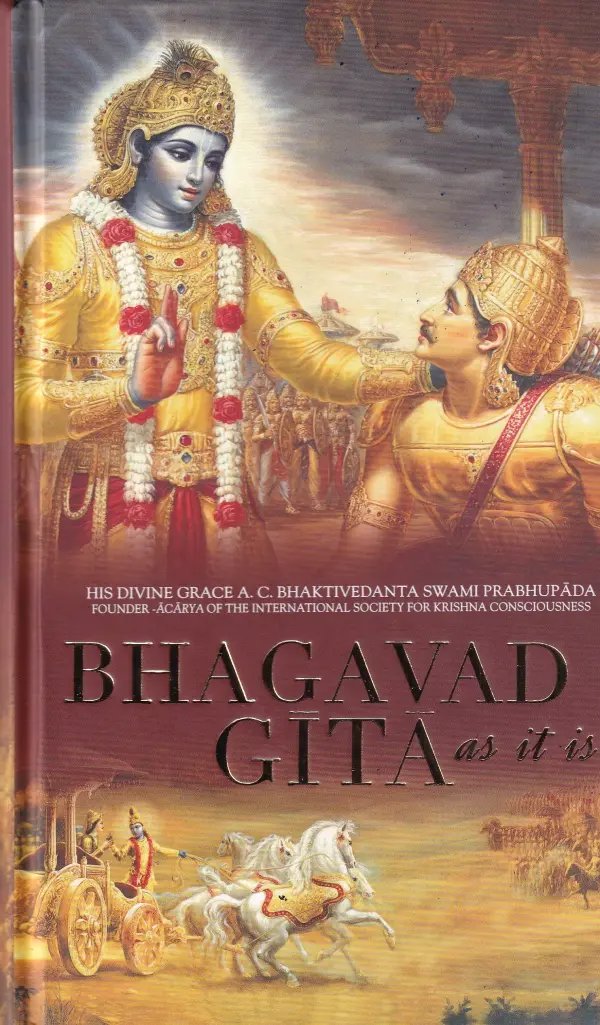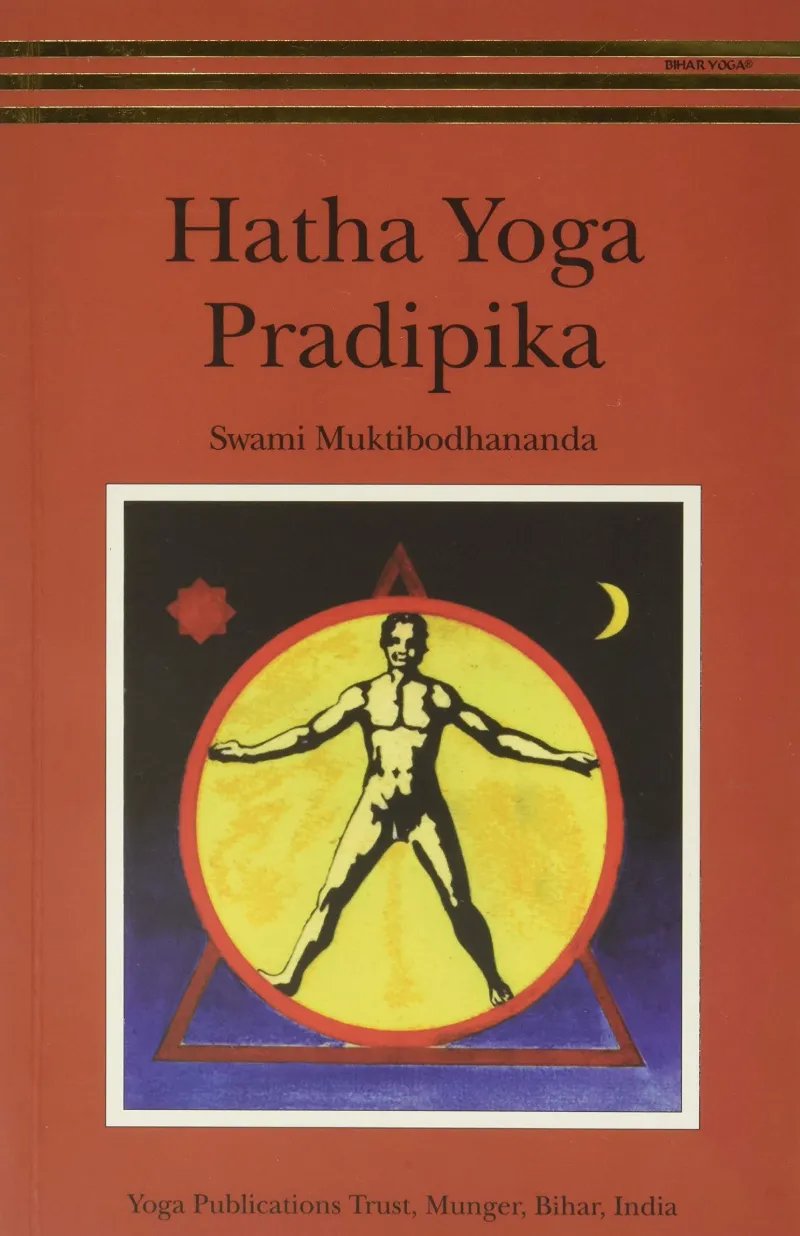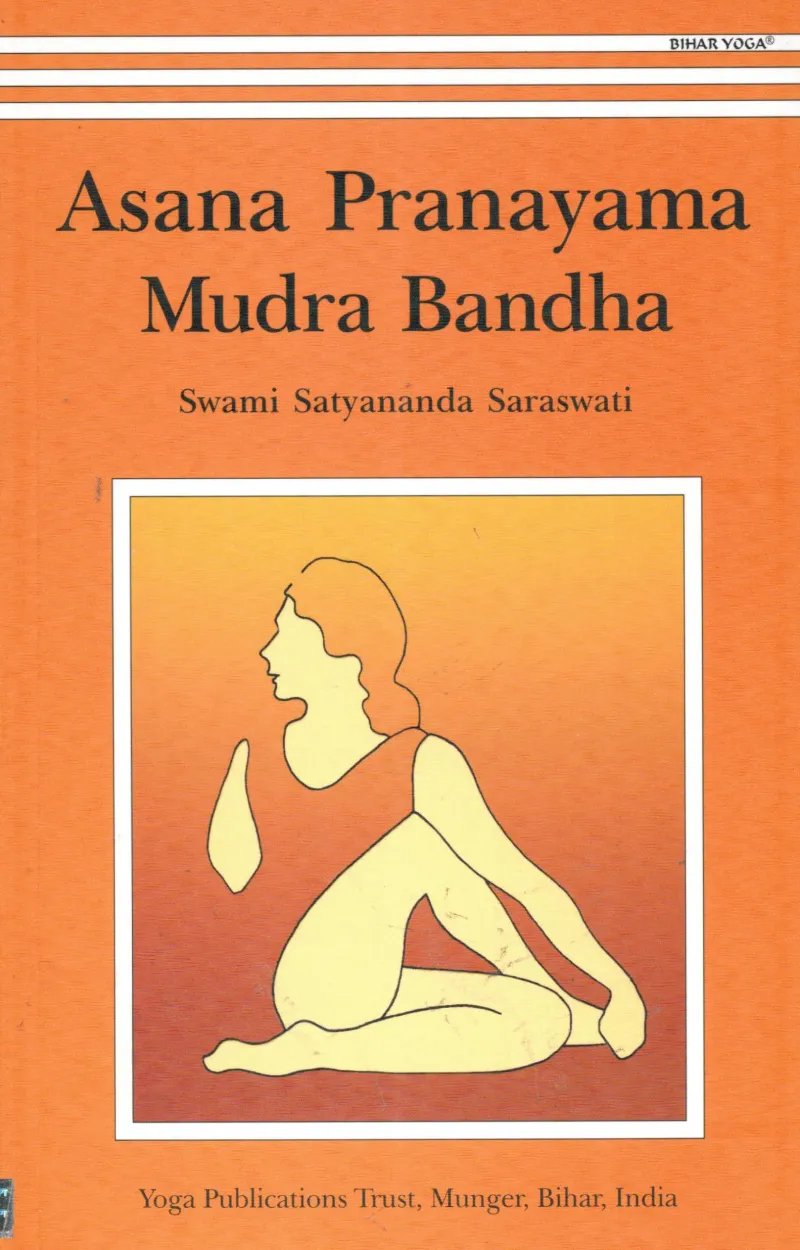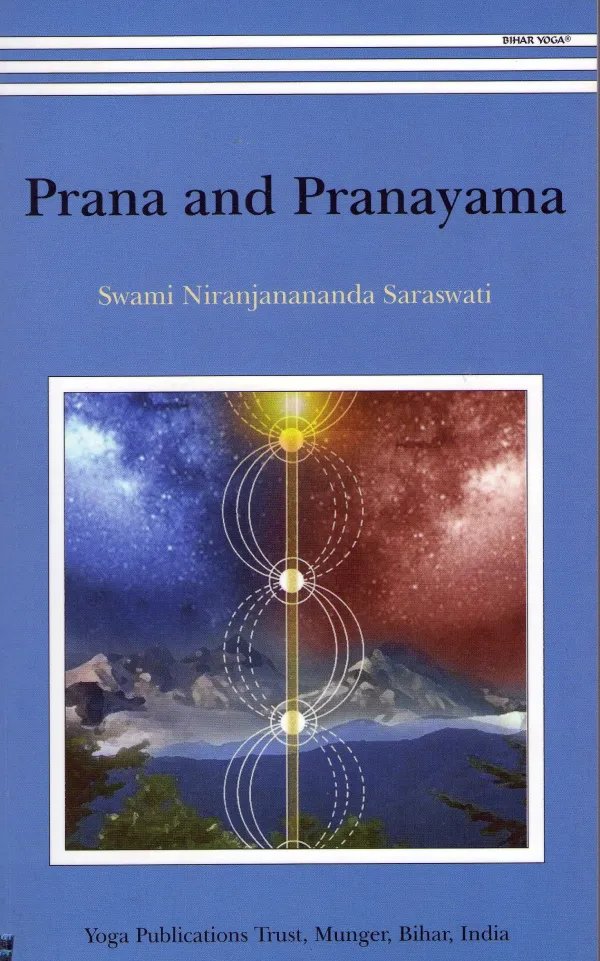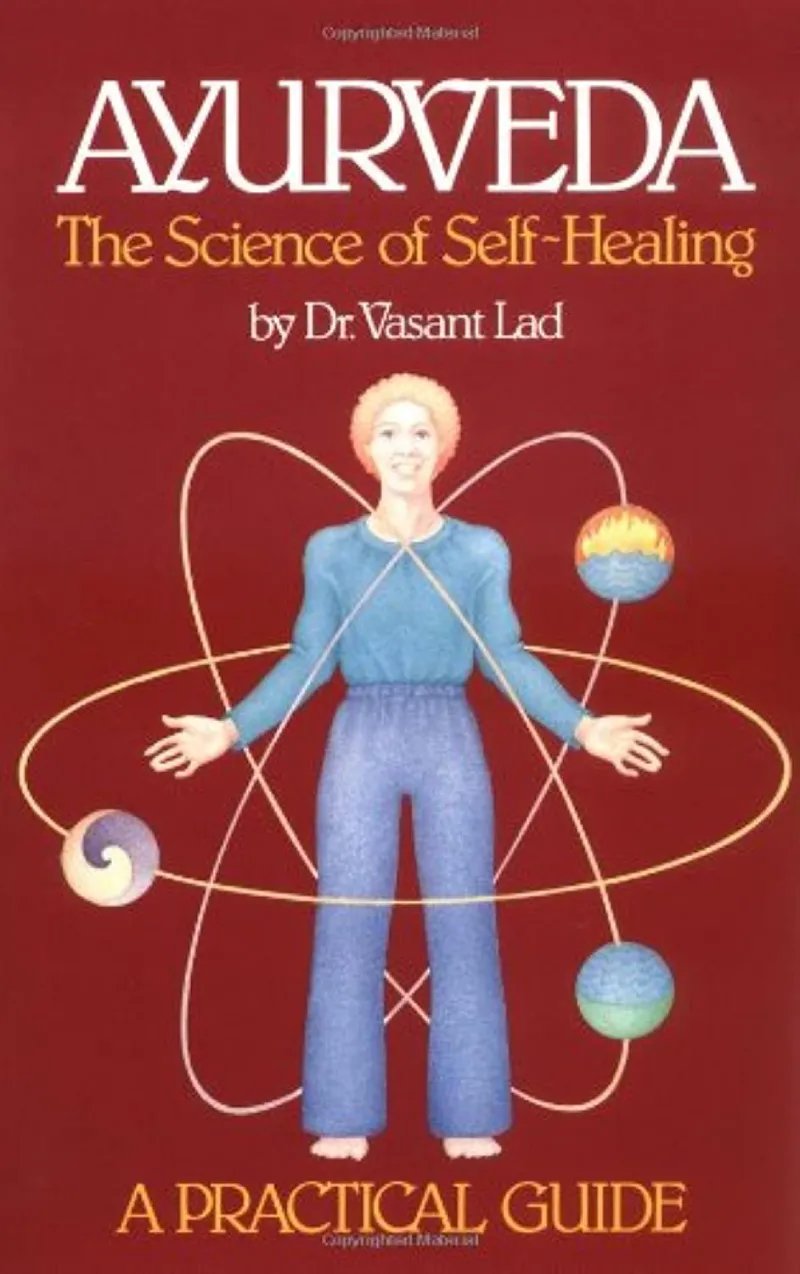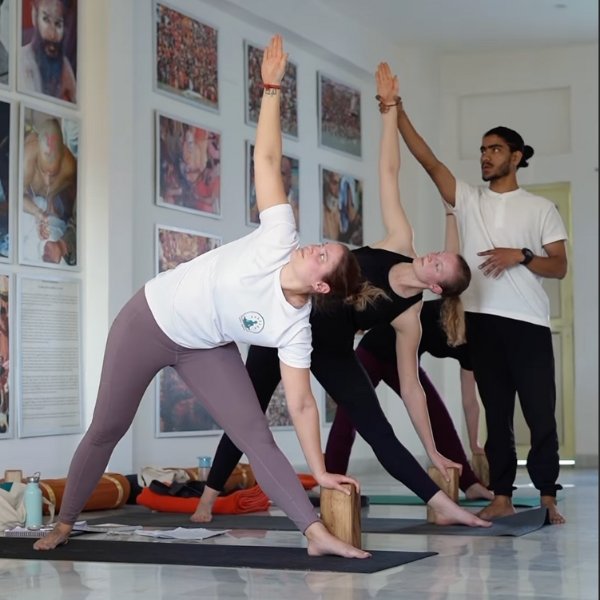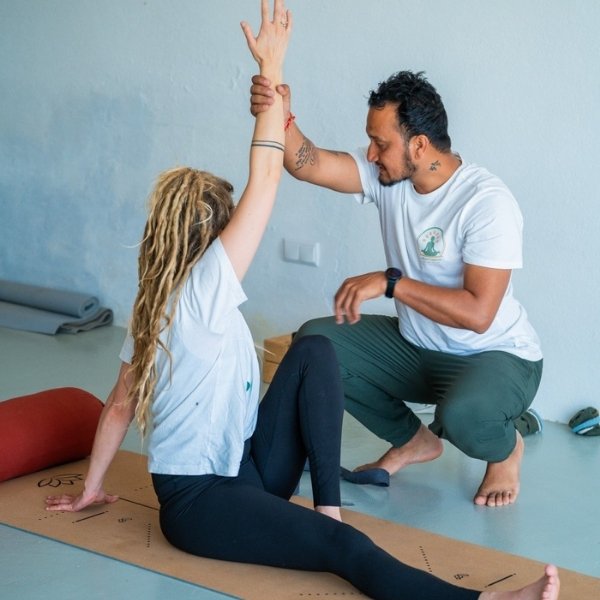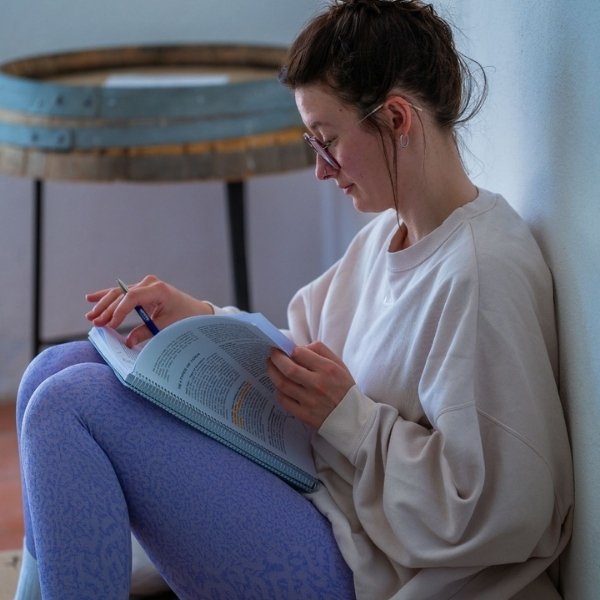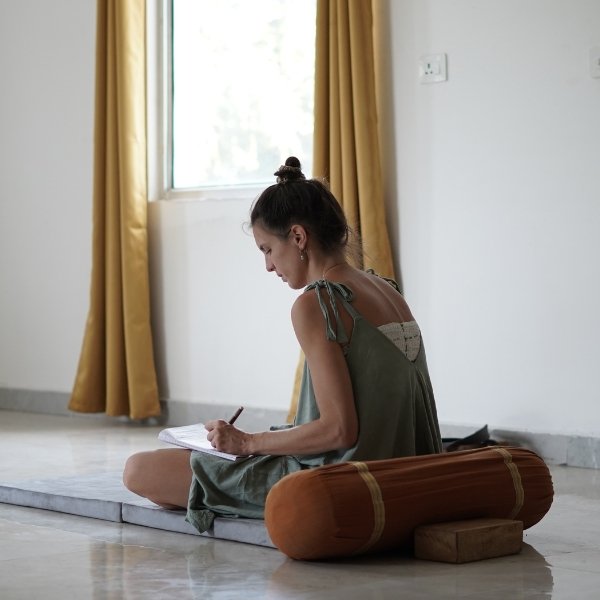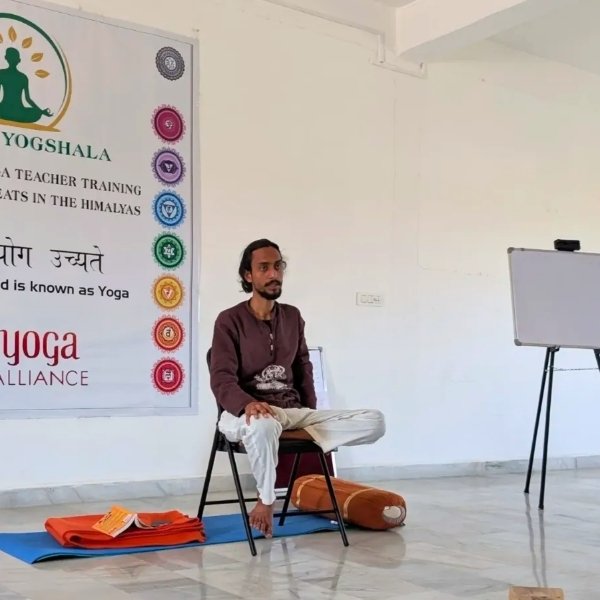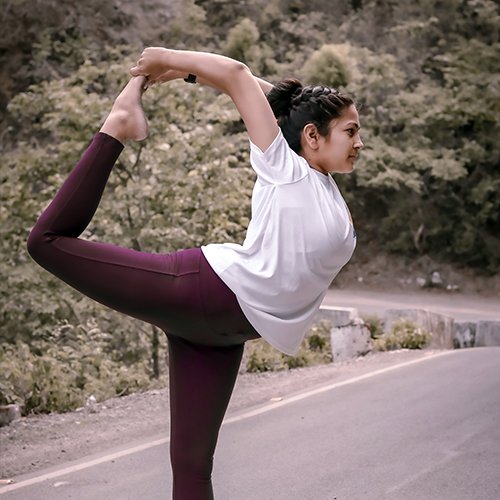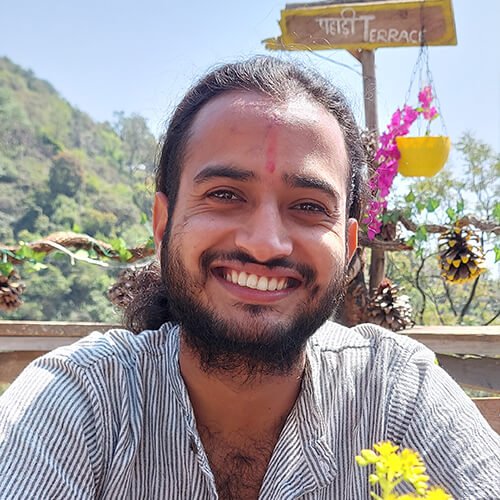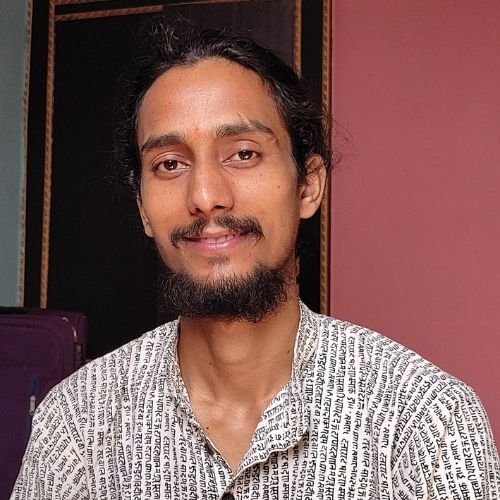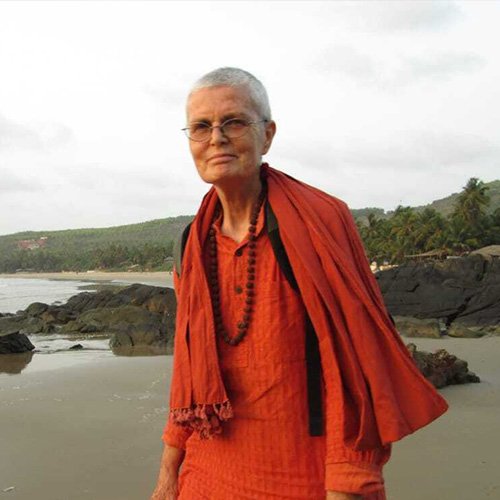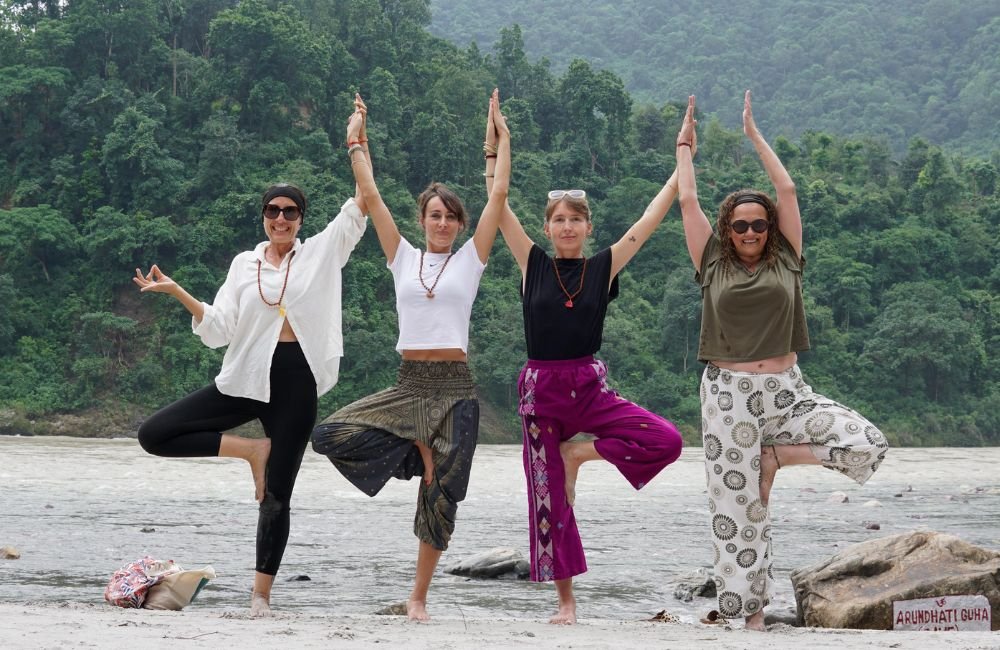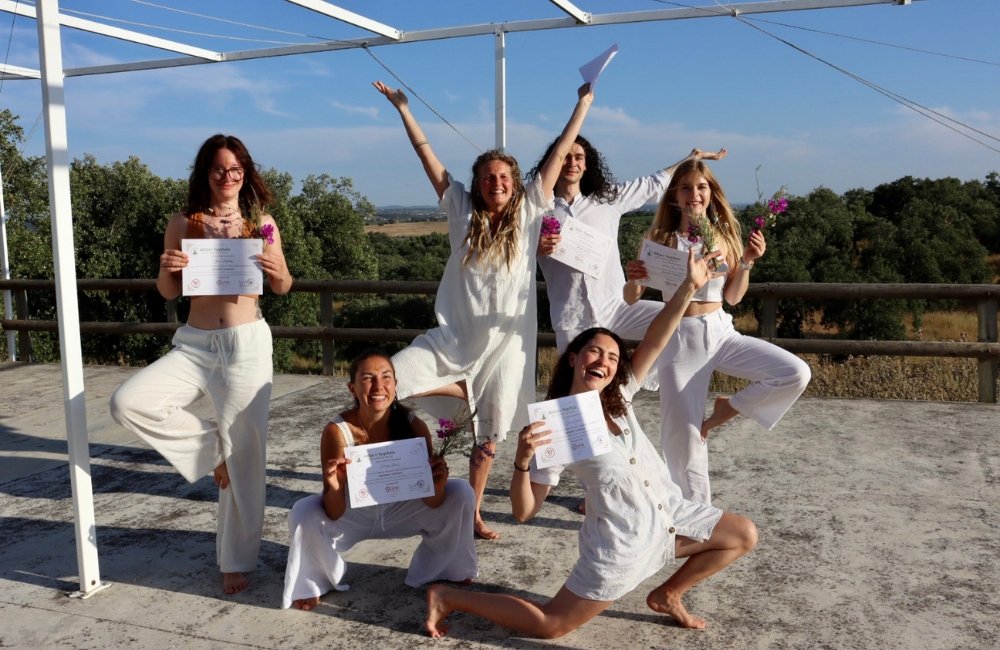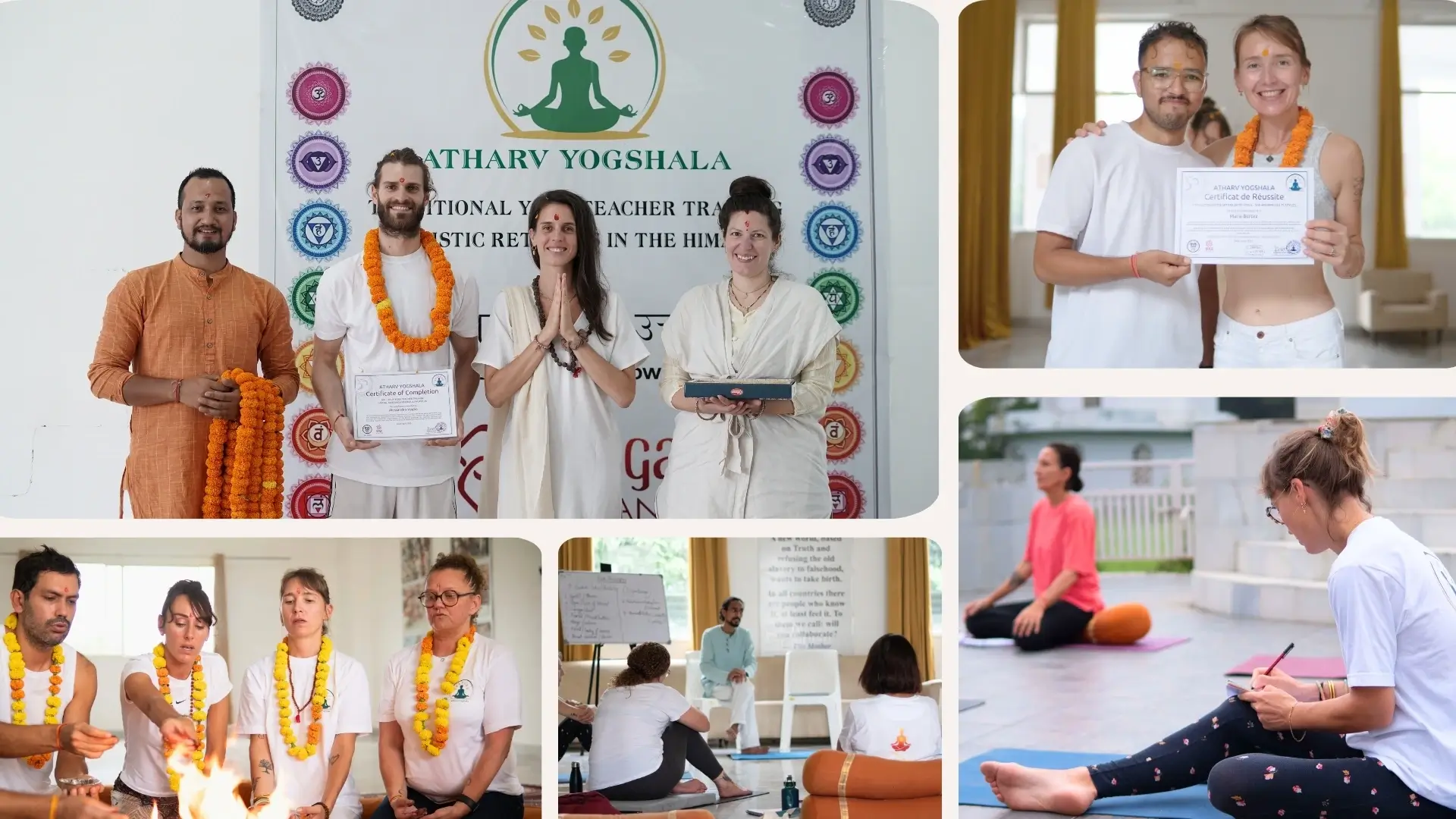300 Hour Yoga Teacher Training in Rishikesh

Have you decided to go deeper into the ocean of knowledge about yoga and meditation? Are you interested in becoming a more confident teacher than ever? Then all you need to know is about the 300 hours yoga teacher training course, which is the best way to refine your practice and teach you everything you are yearning to know in order to become the best teacher you can be.
Make up your mind and get ready to embark on a thrilling journey of 300-hour yoga teacher training in India and Nepal with Atharv Yogshala. Believe us, it will be helpful for you in a personal and professional way too.
Intermediate Level: 300 Hours Yoga Teacher Training
The 300 Hours yoga teacher training course conducted at Atharv Yogshala is of intermediate level and has numerous advantages. The course is designed for those who want to learn more about yoga and improve the depth of their practice. The course is about learning and teaching. The residential yoga course with our yoga school deepens your pre-existing knowledge and skills with advanced asana practice. The course is basically about improving your teaching skills. The course is 28 days long, and during this time, you stay with us in a true yogic environment. You will love to indulge in such an atmosphere.
Who can join the course?
Certainly, yoga only demands your keen interest and dedication. But for this, you do need experience and a certificate. The course is of intermediate level, and you will pick up where you left off. Those aspirants who have a 200 Hours Yoga Teacher Training certificate and are well-versed in the practice of yoga can come and join the course. Because the course is about brushing up on your skills, it is obvious that you must have some prior knowledge.
Apart from having experience and a certificate, you must have the spirit to go deeper into this. Only then you can learn the best of it.
A 32 Days Course with Atharv Yogshala
Atharv Yogshala is a registered yoga school in Rishikesh (Uttarakhand). We run the residential courses over a period of 32 days to ensure that you learn them thoroughly. To ensure a homey stay, we provide sattvic food and a comfortable stay for our students. These 4 weeks might be challenging for you as you stay away from your family and friends, but our teachers and team will create the most positive environment for you.
The teachers at Atharv Yogshala are highly qualified with years of experience in the same field. They teach every topic precisely so that you can become a master of it. The theoretical and practical sessions are meant to clear your doubts and make you aware of each and every aspect of yoga.
Atharv Yogshala offers a secure and clean environment. You will get a chance to balance your life and get to transform it with us in the most promising way. We ensure to meet the needs of every student. Our belief is that the world is one family.
Whatever you learned in the last courses is enough! but there is always a line above enough, i.e., a plenitude. And when it comes to gaining knowledge in yoga, meditation, or other spiritual activities, you definitely need a plethora of it. So, the 300 Hours Yoga TTC awards you with a plethora of skills and knowledge.
Course Fees & Dates

Date
Fees
Availability
Booking
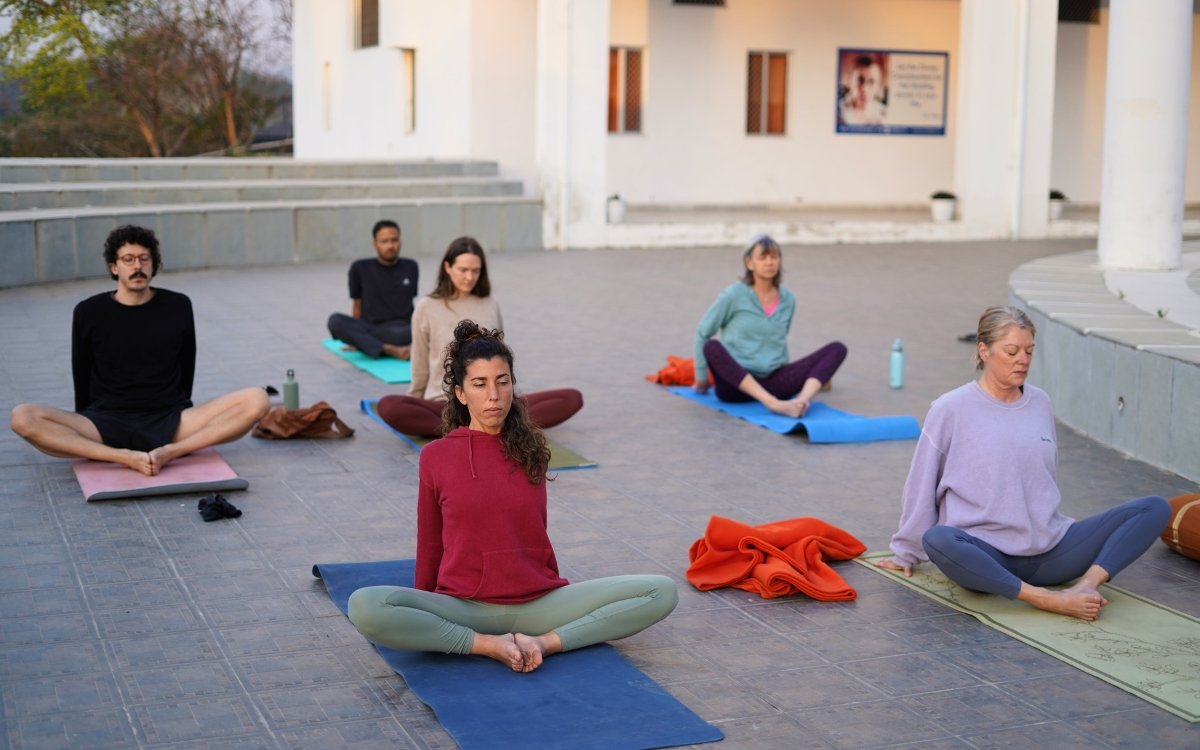
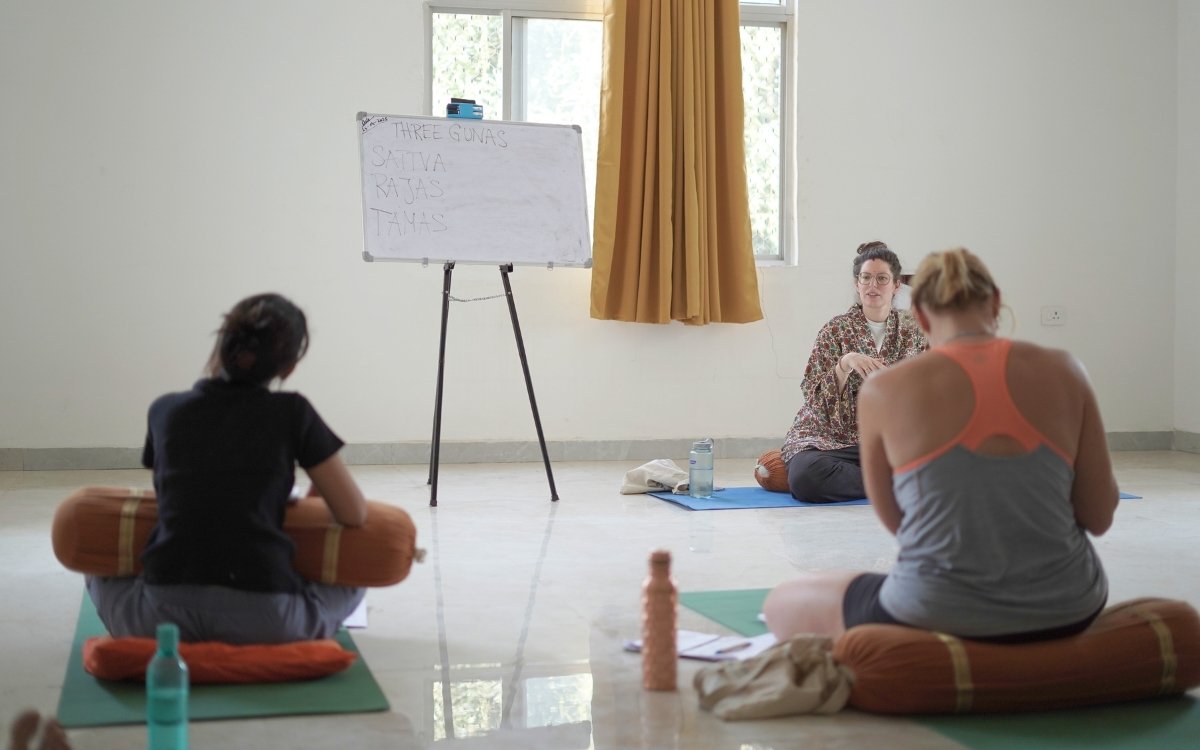
Course Inclusions & Exclusions

Yoga Certification - 300 Hour YTTC

All participants completing a 200 hour yoga training course are eligible to register with Yoga Alliance as RYT 300 hour, which is an internationally recognized yoga teacher certification and designation.
You will be able to develop your understanding of yoga at Atharv Yogshala to the point where you will be able to teach yoga professionally. Our graduates can apply to Yoga Alliance to become registered yoga teachers, such as RYT 200, RYT 300 & RYT 500, according to their qualifications.
Evaluation of 300 Hour Yoga TTC in Rishikesh
The overall evaluation of 300 hours Yoga teacher training at Atharv Yogshala India based on below assessment:
- Written assessment - Completion of assignment
- Practical assessment - designing, sequencialising and conducting Yoga session
- Student's conduct throughout the training will be an essential criteria
- Attendance - minimum 90% wherein student must have presented the valid and agreed reason for 10% absenteeism
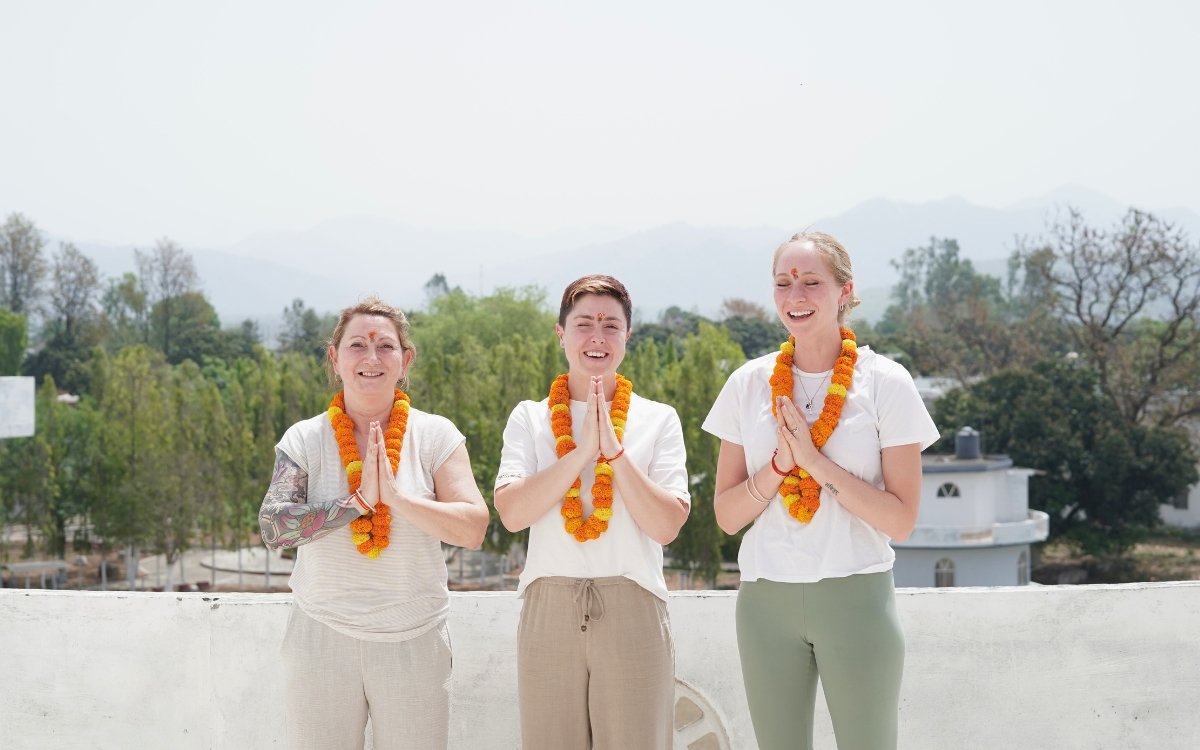
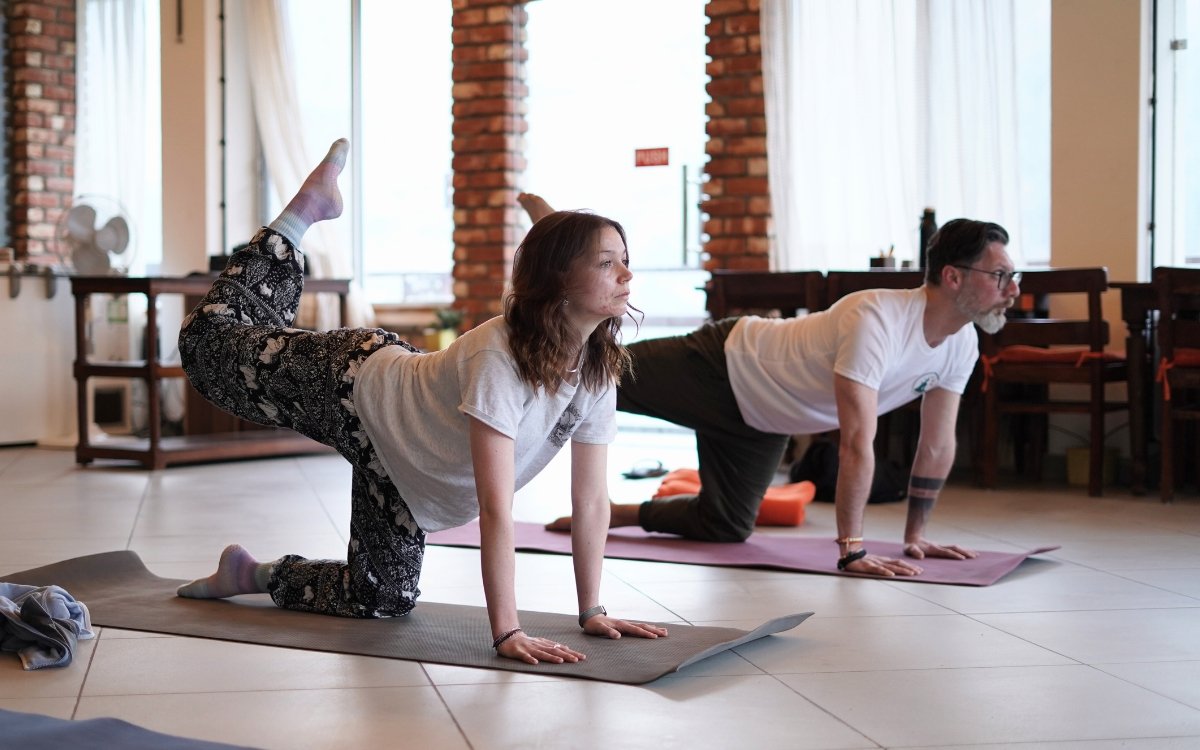
Course Syllabus: 300 Hour YTTC

At Atharv Yogshala, we offer various yoga teacher training courses to students who are willing to learn the best in the field of yoga and meditation. The curriculum is entirely based on Yoga Alliance standards. We offer residential courses with extra classes in Ayurveda. With our course, we aim to balance our lives and transform them in a positive way. We work in the belief that the world is one family, and with our courses, it is our duty to meet the needs of every individual.
165 Hours
Techniques, Training and Practice
Asana | Assignment | Pranayama | Meditation
30 Hours
Anatomy & Physiology
Introduction to Body and More
45 Hours
Yoga Humanities
History | Philosophy | Ethics
60 Hours
Professional Essentials
Teaching Methodology | Professional Development | Practicum
Ashtanga is a dynamic version of hatha yoga. It is a six-level yoga style with a proper series of postures. More than a teaching session conducted by yog gurus, Ashtanga Yoga is a self-assisted and practice class. All students are doing the same sequence and postures, supported by experienced teachers.
Standing Postures
- Samasthiti
- Sun salutation A & B (Surya Namaskar Series A & B)
- Padangushtasana (Big toes Posture)
- Pada hastasana (Hand under foot posture)
- Utthita Trikonasana (Triangle posture)
- Parivritta Trikonasana (Revolved Triangle Pose)
- Utthita Parshvakonasana (Extended Side Angle Pose)
- Parivritta Parshvakonasana (The Revolved Side Angle Pose)
- Prasarita Padottanasana (A, B, C & D) (Wide-legged Forward Fold A, B, C & D)
- Parshvottanasana (Side Stretch Pose)
Intermediate Postures
- Pasasana (Noose Pose)
- Krounchasana (Heron Pose)
- Shalabhasana A, B (Locus Pose A, B)
- Bhekasana (Frog Pose)
- Dhanurasana (Bow Pose)
- Parsvadhanurasana (Side Bow Pose)
- Ustrasana (Camel Pose)
- Laghu Vajrasana (Small Thunderbolt Pose)
- Kapotasana (Pigeon Pose)
- Supta Vajrasana (Reclined Thunderbolt Pose)
- Bakasana (Crane Pose)
- Bharadvajasana (Seated Spinal Twist Pose)
- Ardha Matsyendraasana (Half Lord of the Fishes Pose)
- Ekapada Sirsasana A, B, C (Seated foot-behind-the-head Pose)
- Dwipada Sirsasana B (Feet behind the head pose)
- Yoga Nidrasana (Yogic Sleep Pose)
- Tittibhasana A, B, C (Firefly Pose A, B, C)
- Pincha Mayurasana (Peacock Feather Stand)
- Karandavasana (Himalayana Duck)
- Mayurasana (Peacock Pose)
- Nakrasana (Crocodile Pose Variation)
- Vatayanasana (Horse Pose)
- Parighasana (Gate Pose)
- Gomukhasana A, B, C (Cow Face Pose)
- Supta Urdhvapada Vajrasana A, B (Reclining Thunderbolt Pose One Foot Upward A, B)
- Mukta Hasta Sirsasana A, B, C (Free Hands Headstand Pose A, B, C)
- Baddha Hasta Sirsasana A, B, C, D (Bound Hands Headstand Pose A, B, C, D)
- Urdhva Dhanurasana (Upward-facing bow Pose)
- Paschimottanasana (West Stretching Pose)
Intermediate Postures
- Salamba Sarvangasana (Supported all limbs Pose)
- Halasana (Plow Pose)
- Karnapidasana (Ear-pressure Pose)
- Urdhva Padmasana (Upward Lotus Pose)
- Pindasana (Embryo Pose In Shoulder Stand)
- Matsyasana (Fish Pose)
- Uttana Padasana (Raised Leg Pose)
- Shirshasana (Headstand Pose)
- Baddha Padmasana (Bound Lotus Pose)
- Yoga Mudra
- Padmasana (Lotus Pose)
- Uth Pluthi or Tolasana (Sprung Up)
- Shavasana (Corpse Pose)
Ayurveda is the oldest and the most natural system of medicine that originated in India years ago. It is approximately 3000 years ago medicinal science. Ayurveda is derived from two words, "Ayur" means "Life" and "Veda" means "Science", thus Ayurveda describes the meaning "Science of Life" or 'Knowledge of Life'. As per Ayurvedic Science, the body is made up of five elements, i.e. Akash (Ether), Vayu (Air), Agni (Fire), Apas (Water), and Prithvi (Earth). These 5 elements create 3 doshas namely, Kapha, Vata and Pitta. When these are balanced, then an individual remains healthy and when these are imbalances, an individual remains ill. Ayurveda helps in balancing all of these to give you a healthy lifestyle.
The 300 Hours Yoga Course explains;
- What is Ayurveda?
- Fundamentals of Ayurveda
- Tridosha (Vata, Pitta and Kapha)
- Prakriti (Know Your Constitution)
- Pancha Mahabhuta [Earth (Prithvi), Water (Jal), Fire (Agni), Air (Vayu) and Aether / Space (Aakash)]
- Vikurti (After Creation)
- Sapta Dhatu or 7 Body Elements (Rasa, Rakta, Mamsa, Meda, Asthi, Majja and Sukhra)
- Mala (Waste Products)
- Srotas (Body Channels) - 16 as per Ayurveda
- Agni (Digestive Fire)
- Koshta (Alimentary Tract)
- Ama (Undigested Metabolic Toxins)
More than a teaching session conducted by yog gurus, Mysore Style Ashtanga Yoga is a self-assisted and practice class. All students are doing the same sequence and postures, supported by experienced teachers.
- Introduction
- History
- Awakening the Inner Fire
- The Breath of Life (Prana)
- Chakras
- Eight Limbs of Yoga (Ashtanga Yoga)
- The practice of K.Pattabhi Jois
- Bandha practice
- Drishti (Focusing the Attention)
- Use of yoga props and instruments
- Sun Salutation A & B (week 1) - Surya Namaskar Series A & B
- Standing Asana Series (week 2)
- Sitting Asana Series (Week 3)
- Finishing Asana Series (Week 3)
- Teaching Practices (Traditional & Mysore Style- Week 4)
- Padangustasana (Big toes Posture)
- Pada hastasana (Hand under foot posture)
- Utthita trikoṇasana (A+B) (Triangle posture)
- Utthita parsvakonasana (A+B) (Extended side angle pose)
- Prasarita padottanasana (A,B,C,D) (Intense wide leg stretch)
- Parsvottanasana (Intense side stretch posture)
- Utthita hasta padangustasana (Hand to big toe posture)
- Ardha bandha padmottanasana (Half-bound lotus forward bend)
- Utkatasana (Fierce pose)
- Virabhadrasana (Warrier pose) A+B
- Dandasana (Staff pose)
- Pascimattanasana (Intense west stretch or sitting forward bend)
- Purvattanasana (Intense east stretch)
- Ardha bandha padma pascimattanasana (Half bound lotus forward bend)
- Tiryangmukha Eka pada pascimattanasana (Reverse the leg, one leg intense stretch)
- Janusirsasana (Head-to-knee pose)
- Marichyasana (Leg Binding Pose)
- Navasana (Boat Pose)
- Bhujapiḍasana (Shoulder Pressure Pose)
- Kurmasana (Tortoise Pose)
- Suptakurmasana (Reclining Turtle Pose Yoga)
- Garbhapindasana (Womb Pose)
- Kukkutasana (Cockerel Pose, or Rooster Posture)
- Baddha Konasana (Bound Angle Pose, Butterfly Pose)
- Upavistha Konasana (Seated Angle Posture)
- Suptakonasana
- Supta Padangustasna
- Ubhaya Padangustasna
- Urdhvamukha Pascimattanasana
- Setubandhasana (Bridge Pose)
- Finishing Postures
- Urdhva Dhanurasana (upward bow posture)
- Salaṁba sarvangasana (shoulder stand posture)
- Halasana (plough posture)
- Karṇa pidasana (ear pressure posture)
- Baddha padmasana (sealed lotus pose)
- yoga mudra (sealed yoga posture)
- Padmasana (Lotus posture)
- Savasana (Corpse pose)
Bandhas is the Sanskrit word which means Lock. The aim of it is to block the energy flow from a particular part of the body. When the lock is opened, then the energy flows properly throughout the body and maintains overall wellness and vitality.
What'll you learn?
- Meaning and Importance of Energy Lock
- Kundalini Awakening
- Bandhas and Prana
- Unblocking the system for energy flow through Bandha
- 3 Energy Knots (Brahma, Vishnu, and Shiva) and How to Open Them
- The outcome of Bandhas practice
- Precautions
- Health and Spiritual Benefits
- Practices (Beginners and Intermediate Level)
- Agnisar - Advance Level (Preparation to Uddiyana)
- Advance Level Vahir Kumbhaka (External Retention)
- Advance Level Antar Kumbhaka (Internal Retention)
- Ashwini Mudra to prepare Mulabandha
- Vajroli Mudra to prepare Mulabandha
- Mula bandhas (Anal lock)
- Uddiyana bandha (Abdominal lock)
- Jalandhar Bandha (Throat Lock)
- Maha Bandha (Great Lock)
Prana, the life energy Yama means control. It is the foundation practice of the traditional form of yoga. It is not just a breathing practice but much more than this. The class of pranayama reveals its secrets and the power of pranayama to gain the right health, peace, and balance.
The four week course offers a different experience, such as;
- Week 1: Step wise knowledge of pranayama and building strength.
- Week 2: From the beginning to the deep core of pranayama.
- Week 3: Advance practice by holding the breath and manifesting chakra awareness.
- Week 4: Teaching practice while moving to the master level of the breath.
Pranayama Topics:
- Definition of Prana
- Definition of Pranayama
- Definition of breath
- Connection of the Prana and the breath
- Importance of Pranayama
- Benefits of Pranayama
- Preparing ourselves to practice pranayama
- Aspects of Breathing
- Ancient Texts of Breathing
- General understanding
- Knowledge of nostrils
- Activating nostrils for pranayama
- Secrets of Pranayama
- Breath flow in 5 elements
- Unit of Prana
- Function of Prana
- Three levels of Prana
- Three Gunas
- Flow of Prana
- Quality of breath
- Imbalance of Prana
- Retention of breath
- 6 Sitting postures for Pranayama practices
- Breathing pattern
- Chakras and Kundalini connect with Prana
- Beginners and Intermediate Practices of Pranayama
- Clavicular Pranayama
- Thoracic Pranayama
- Diaphragmatic Pranayama
- Yogic Pranayama
- Pranava Pranayama (Om Meditation Breathing)
- Nadi Shodhana Pranayama or Anulom Vilom Pranayama
- Bhastrika Pranayama (Bellows Breath)
- Kapalbhati Pranayama (Skull Shining Breath)
- Bhramari Pranayama (Humming Bee Breath)
- Ujjayi Pranayama (Ocean Breath)
- Sitali Pranayama (Cooling Breath)
- Sitkari Pranayama (Hissing Breath)
- Murcha Pranayama (Swooning Breath Yoga)
- Surya Bhedi Pranayama (Right Nostril Breathing)
- Chandra Bhedi Pranayama (Left Nostril Breathing)
Hatha Yoga sessions conducted by our school are a positive workout for one's physical and mental wellness. It originated years ago with the aim to attain health and peace. The practice also benefits you with strength and flexibility.
Hatha Yoga works on the basic aim of;
- Promoting health and longevity
- Strengthening the mind
- Awakening the Kundalini
Practices:
- Joints and glands exercise foundation practices
- Joints and glands exercise advanced practices
- Centering postures series (Yoga Sequence Builder)
- Surya Namaskar (Sun Salutation)
- Chandra Namaskar (Moon Salutation)
- Standing postures series
- Kneeling postures series
- Sitting Postures series
- Forward bending postures series
- Backward bending postures series
- Supine postures series
- Prone Postures series
- Fire Series series
- Inversions series
- Twisting postures series
- Balancing Postures series
- Relaxing Posture series
- Meditative Asana Series
Philosophy Of Hatha Yoga
You have done practice sessions but what about theory? It is also as important as practice sessions. If you are not theoretically aware of Hatha yoga and its elements, you are not able to practice it well.
- Surya Namaskar Philosophy
- Hatha Yoga Philosophy
- Kundalini Awakening
- Asanas
- Yog Sadhana
- Benefits of Hatha Yoga Asanas
- Rules and Regulations
- Advancing Yoga Poses
The four weeks program work as;
- Week 1: Introducing Meditation and Building Foundation
- Week 2: Making the mind able to focus on a single aspect with concentration process and exercises.
- Week 3: Meditation Techniques
- Week 4: Chakra Awareness and Kundalini Meditation
What'll you learn?
- What is Meditation?
- History and Origin of Meditation
- How to prepare yourself for Meditation?
- What Meditation is actually?
- What Meditation is not?
- Why to meditate?
- How to meditate?
- Where to meditate?
- When to meditate?
- Philosophy of Meditation
- Meditation Traditions
- Meditation Scriptures
- Aim and Objectives of Meditation
- Sitting Positions
- How to Sit Correctly
- Preliminary Practices Before Practicing Meditation
- Diaphragmatic Breathing in Meditation
- Correct Breathing in Meditation
- How to Relax in Meditation?
- Lifestyle in Meditation
- Diet of Meditation
- Why should one sleep while meditating?
- What are the rules of meditation?
- Styles of Meditation Practices
- Himalayan Meditation Practices
- Basics Foundation Meditation Practice
- Breath- Mind- Mantra Awareness
- Trataka Meditation
- Nada Meditation Practices
- Music Meditation
- Om Meditation
- Mantra Power Meditation
- Active Meditation Practices
- Dynamic Moving Meditation (Osho)
- Buddha Walking Meditation
- Karma Yoga Meditation
- Natraj Meditation
- Sufi Meditation
- Gaurishankar Meditation
- Ajna Chakra Awakening Meditation
- Kundalini Active Meditation
- Vipassana & Passive Meditation Practices
- Breath Awareness (Anapana)
- Mindfulness and Sensation
- Total Awareness Practice
- How to Do Japa (recitation)
- Kirtan Even and Creating a Spiritual Vibe
- One-Day Silence Meditation
- Silence Practice
Mantras are sacred sounds, words, or phrases which are recited to attain spiritual attention. In other words, a mantra is a tool of the mind. It helps the mind in focusing better.
Mantra Healing
- Mantras for physical healing
- Mantras for mental healing
- Mantras for emotional healing
- Mantras for spiritual healing
Mantras for planetary disorders
- Mantra for sun
- Mantra for moon
- Mantra for Saturn
- Mantra for vrihaspti/guru
- Mantra for Mangala
Mantra for healing the different diseases
- Mantra for Cancer
- Mantra for HBP
- Mantra for heart problem
- Mantra in pregnancy
- Mantra for stress relief
- Mantra for concentration
Mantra Healing for all planets
- Surya Mantra (Sun Mantra) -Om Hring Hraung Suryay Namah
- Chandra Mantra (Moon Mantra) - Om Aing Kling Somay Namah
- Mangala Mantra - Om Hung Shring Bhaumay Namah
- Buddha Mantra - Om Aing Shring Shring Budhay Namah
- Brihaspati Guru Mantra - Om Hring Cling hung Brihsptye Namah
- Shukra Mantra - Om Hring Shring Shukray Namah
- Shani Mantra - Om Aing Hring Shring Shanaishchray Namah
- Rahu Mantra - Om Aing Hring Rahave Namah
- Ketu mantra - Om Hring Aing Ketave Namah
Chakras are energy points of the body. They are believed to be spinning disks which is needed to be open and aligned for healthy well-being. In the human body, there are 7 chakras.
Characteristics of each chakra;
Muladhara Chakra or Root Chakra
- Sound: Lam
- Location: Between the anus and genitals, the base of the spine
- Petal: Four Petals
- Color: Red
Swadhistana or Sacral Chakra
- Sound: Vam
- Location: Below the bellybutton
- Petal: Six Petals
- Color: Orange
Manipura or Solar Plexus Chakra
- Sound: Ram
- Location: The Upper Abdomen
- Petal: Ten Petals
- Color: Yellow
Anahata or Heart Chakra
- Sound: Yam
- Location: Above the heart
- Petal: Twelve Petals
- Color: Green/Pink
Visuddha or Throat Chakra
- Sound: Ham
- Location: Throat
- Petal: Sixteen Petals
- Color: Blue
Ajna or Third Eye Chakra
- Sound: Om
- Location: Between the eyebrows
- Petal: Two Petals
- Color: Indigo
Sahasrara or Crown Chakra
- Sound: Silence
- Location: Top of the head
- Petal: One Thousand Petals
- Color: Violet, Gold, White
Just like you involve your body in physical exercise for its benefits, in the same way, meditation is an exercise for mental health. With the power of meditation, you can control your mind and block negative and unnecessary thoughts. You enter into a deep state of relaxation where peace is the ultimate goal. During the meditation class, you are advised to sit quietly by keeping your focus on a single thing. It helps you in eliminating tension and stress. With the 300 Hours yoga teacher training course, you get to learn basic and intermediate techniques of meditation. The four weeks program work as;
- Week 1: Introducing Meditation and Building Foundation
- Week 2: Making the mind able to focus on a single aspect with concentration process and exercises.
- Week 3: Meditation Techniques
- Week 4: Chakra Awareness and Kundalini Meditation
What'll you learn?
- Mind and its role in meditation
- Nature of mind
- Why the mind is anxious?
- Meditation as Reverse Journey of Pratiprasava
- Brain Waves
- Music and Meditation
- Emotional Purification Meditation
- Past Life Healing with Meditation
- Samadhi with Meditation
Styles Of Meditation Practices
Himalayan Meditation Practices
- Advance Foundational Meditation Practice
- Breath- Mind- Mantra Awareness
- Trataka Meditation
- Anapana Meditation
Nada Meditation Practices
- Music Meditation
- Pranava Meditation
- Advance Mantra Meditation
Active Meditation Practices
- Dynamic Moving Meditation (Osho)
- Contemplative walking
- Meditation in daily life
Tantra & Kundalini Meditation Practices
- Meditation for Muladhara Chakra
- Meditation for Swadhisthana Chakra
- Meditation for Manipura Chakra
- Meditation for Anahata Chakra
- Meditation for Visuddhi Chakra
- Meditation for Ajna Chakra
- Meditation for Sahasrara Chakra
- Guru chakra Meditation
- Kundalini Meditation
Vipassana & Passive Meditation Practices
- Breath Awareness
- Mindfulness and Sensation
- Total Awareness Practice
Mudra is a symbolic gesture. It is normally practiced with hands and fingers, explaining the flow of energy in the subtle body. It brings a wondrous change in body and mind.
The 300 Hours Yoga Course explains;
Hasta Mudra (Hand Mudra)
- Yoni mudra
- Linga Mudra
- Bhairava Mudra
- Bhairavi Mudra
- Energy Mudra
- Viparita Karnai Mudra
- Mahabandha Mudra
- Mahabheda Mudra
- Kundalini Mudra
- Ashwini Mudra
- Vajroli Mudra
- Sahajoli Mudra
Prana, the life energy Yama means control. It is the foundation practice of the traditional form of yoga. It is not just a breathing practice but much more than this. The class of pranayama reveals its secrets and the power of pranayama to gain the right health, peace, and balance.
Four Weeks of Pranayama
- Week 1: Advanced pranayama practices
- Week 2: Variations and experiments
- Week 3: Awakening nadis and chakras
- Week 4: Teaching practices and mastery of breathing
Topics:
- What is Pranayama?
- How pranayama brought happiness
- Physiology of prana
- Elements in nature of prana
- Prana body types
- Astrology of Breathing science
- Prana and it routes
- How prana flows in the body
- Prana & Consciousness
- Number of breaths we take
- Research on prana
- Health parameter with breath length
- Guideline and discipline of pranayama
- Intermediate and Advance Practices of Pranayama
- Clavicular Pranayama (Upper Chest Pranayama)
- Thoracic Pranayama (Middle Chest Pranayama)
- Koshtiya (Diaphragmatic Pranayama)
- Full body Yogic Pranayama
- Pranava Pranayama (Om Meditation Breathing)
- Nadi Shodhana Pranayama or Anulom Vilom Pranayama
- Bhastrika Pranayama (Bellows Breath)
- Kapalbhati Pranayama (Skull Shining Breath)
- Bhramari Pranayama (Humming Bee Breath)
- Ujjayi Pranayama (Ocean Breath)
- Sitali Pranayama (Cooling Breath)
- Sitkari Pranayama (Hissing Breath)
- Murcha Pranayama (Swooning Breath Yoga)
- Surya Bhedi Pranayama (Right Nostril Breathing)
- Chandra Bhedi Prana
In yoga, anatomy is a crucial subject for yoga teachers and learners. In the class, you will get to know physical anatomy and spiritual anatomy.
Physical Anatomy
- Prana supply to the respiratory system
- Function of cells
- Digestive system
- Circulatory system
- Endocrine system
- Physical transformation with yoga
- Hormone secretion in yoga
- Effects of pranayama on the respiratory system
- Effects of Yoga practice and Nauli on the digestive system
- A muscular and skeletal system with advanced postures
- Therapeutic applications of Yoga postures
- Avoid injuries in asana class
- Anatomy of pelvic griddle and spine
Physic body Anatomy
- Advanced details regarding the energy channel
- Anatomy of the 7 chakras (Muladhara Chakra, Swadhisthana Chakra, Manipura Chakra, Anahata Chakra, Visuddhi Chakra, Ajna Chakra, Sahasrara Chakra)
- Kundalini (Prime Energy and Souce of All Creativity)
- Pancha Kosha (5 Layers)
"Shat" means "Six" and "Karma" means "Actions". Thus, as per yogic science, Shatkarma is six cleansing actions that help to clean your body and mind. It is well described in the Hatha Yoga Tradition. Shatkarma is an important practice to maintain a balance between body and mind and also promote well-being. The practice eliminates toxins from the body and unblocks energy channels.
With the 300 Hours Yoga TTC, you will learn;
- 11 major systems of the body
- Body purification
- What is Shatkarma or Shatkriya?
- Ancient scriptures of Hatha Yoga Pradipika
- Gheranda Samhita
- Precautions while performing shatkarmas
Practices
- Vamana Kriya (Purification of the upper digestive tract)
- Vastra Dhauti (Cleansing of the stomach and oesophagus)
- Laghu Sankha Prakyalana (Cleasning of the stomach and intestines)
- Bama Nauli Kriya
- Dakshina Nauli Kriya (Cleansing of the right abdomen)
- Vyaghra Kriya
Yoga Therapy Yoga is the wellness science for nurturing the body, mind and spirit. It is the natural healing process to keep you healthy and free from illness. Yoga therapy uses yoga postures, breathing exercises (pranayama), meditation, and other practices to improve physical and mental well-being. Yoga therapy encourages the amalgamation of the body, mind, and spirit.
In the 300 Hours Yoga Course, you will learn;
- The disease of the head and neck
- Headache
- Thyroid
- Heart problems
- Circulatory problems
- Respiratory system and its disorders
- The common cold
- Bronchitis and Eosinophilia
- Asthma
- Sinusitis and Hay Fever
- Tonsillitis
- Disorder of the Digestive system
- Upper Digestive disorders
- Peptic Ulcer
- Constipation
- Colitis
- Acute Gastro Enteritis
- Diabetes
- Hepatitis
- The problem of Obesity
- Arthritis
- Cervical Spondylitis
- Back pain
- Slipped Disk and Sciatica
- Kidney stones
- Menstrual disorder
- Disorders of the male reproductive system
- Hernia
- Skin problems
- Yoga For Health
- Yogic counselling for a healthy life.
- Yogic techniques to use in daily lifestyle.
- Yoga cures common diseases like Headaches, migraine, colds, sinus, etc.
- Yoga tools for back issues like backache, slipped disk, sciatica, diabetes, thyroid.
- What is alignment and why it is important
- What is an Asana , an exercise and a movement
- What is ideal alignment of body
- How to avoid misalignment
- How body can be positioned to optimise the Asana and exercise
- 9 major joints of the body movements patterns
- How to move and position the joints of body with safety and avoid injury
- What are the best possible patterns of movements
- How to prepare for an Asasna
- How to modify and do variation in an Asana
- Common mistakes in Asana
- How to adjust students in Asanas and classes
- Alignment of all types Sun Salutations
- Alignment of standing, balancing, forward bend , backbends, sidebends , twisting and inversions.
Yoga is the education of life and if you wish to clear the advanced yoga program of 300 hours, then do follow the criteria given below:
Students will be tested based on
- Written Test
- Asana Practical Test
- Vinyasa Flow teaching to the class
- Attendance, Performance & behaviour
- Get a registered certificate of the 300 hours yoga ttc with a registered yoga school.
- Stay present in all lectures.
- Submit assignments timely.
- Conduct full yoga sessions.
- Achieve passing marks at the end of the course.
Daily Yoga Schedule

The 300 hour Yoga Teacher Training Course at Atharv Yogshala follows a strict schedule in compliance with Yoga Alliance standards. Nearly 6 to 7 hours of training time are assigned to some aspect of yoga each day. You could find the training intensive but enlightening.
Time
Activity
Schedule on Wednesday
Time
Activity
Please Note: Excursions will be in the Morning / Afternoon / Evening time.
Schedule on Sunday
- Whole day is Rest / Holiday / Field Visits / Outdoor Excursions
- Includes Breakfast / Lunch / Dinner in Campus
Study Materials / Give-away
- Yoga Manual
- Notebook
- Jal Neti Pot, Rubber Neti
- School Bag
- School T-Shirt
Excursions During The Course

Understanding the local spiritual heart is key for our yoga students. Our program offers enriching and peaceful excursions to Yogic Caves, the holy Ganges River, the majestic Himalayas, local cultural spots, and other inspiring destinations.
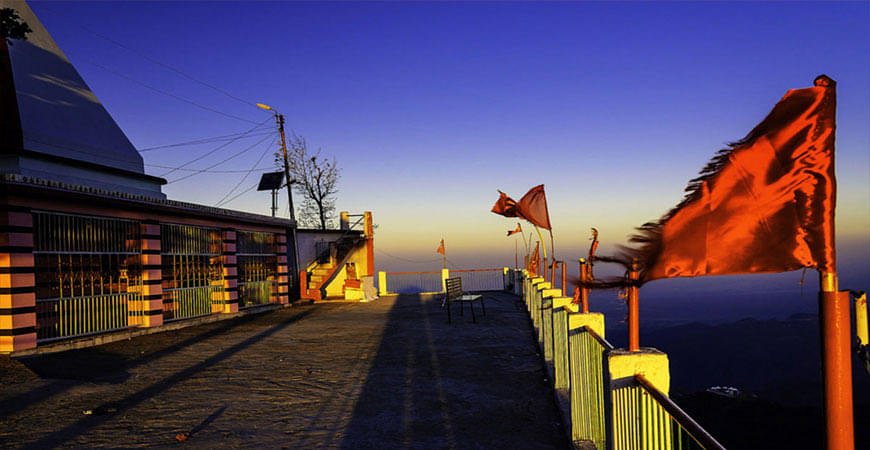
Kunjapuri : Sunrise Tour
Visit Kunjapuri Temple, a revered Shakti Peeth in the Himalayas. At 1600m, enjoy views of snow-capped peaks and the Ganga River from this ancient and beautiful temple. Experience a serene sunrise.
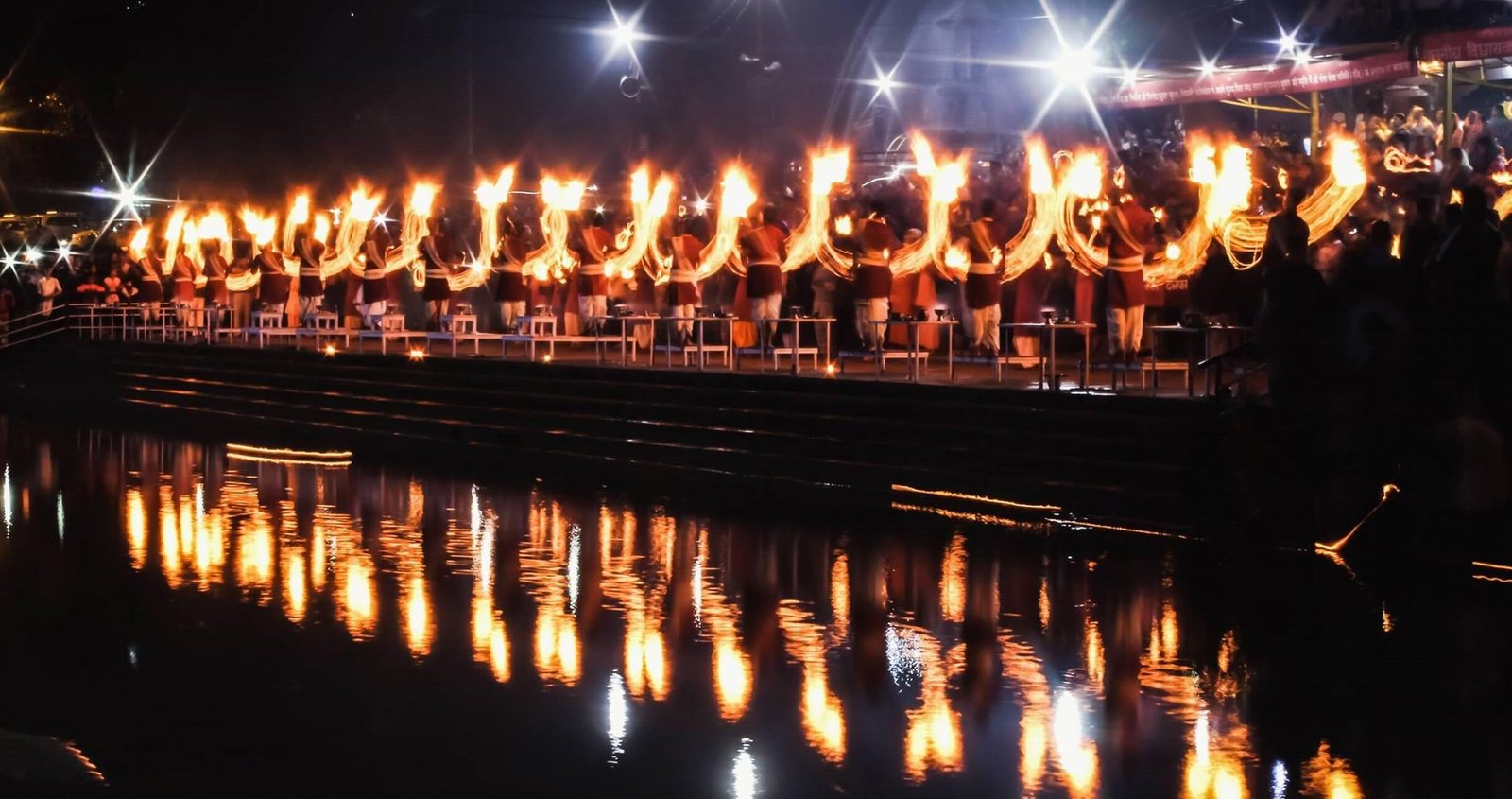
Ganga Aarti - Rishikesh
Witness the Ganga Aarti in Rishikesh, a daily ritual with Vedic chants and prayers to fire. Held at Triveni Ghat and Parmarth Niketan, hundreds join physically, and thousands more virtually, for this spiritual experience.

Itharana Village : Nature Walk
Escape to Itharana, a peaceful Himalayan village. Engage in activities that connect you with nature, away from city life's noise. Experience the tranquility of a rustic setting and enjoy the natural beauty.

Bhootnath Temple
Bhootnath Temple, dedicated to Lord Shiva, is in the Swargashram area behind Parmarth Niketan. This multi-story temple offers amazing panoramic views of Rishikesh from its small main temple on the top floor.
Accommodation & Food

Atharv Yogshala's stay and meals are truly based on yogic patterns. Our accommodation is situated in a beautiful quiet place, a wholly isolated space just outside of Rishikesh. You will be surrounded by nature away from the chaos and busy everyday life and feel calm as soon as you enter the school premises.Atharv Yogshala is a beautiful place for nature lovers and perfect for meditation and finding your true self.
At Atharv yogshala we follow the ashram principals An ashram is a place of temporary retreat where great effort is undertaken to accelerate the transformation process towards self-realization. It is a place of spiritual retreat and growth where you come to know yourself.
An ashram fosters and encourages various types of discipline without which hard work and effort are not possible. It also teaches us how to live with simplicity, rather than indulging in the passing whims of fashion or social trends. The very atmosphere of the ashram environment is infused with spiritual ideals for us to reflect on and absorb.
Stay at Atharv Yogshala
Rishikesh - The small city in Uttarakhand, is undoubtedly the prime choice for yoga lovers, from all over the world. It is also known as the "World's Capital of Yoga." The spiritual atmosphere of the city makes it more vibrant and divine. It is a yoga-centric city. All fully furnished rooms are spacious and well-appointed.
You will find every modern facility in a secure and clean environment at our premises. They are cleaned regularly and have a cabinet and attached bathroom for your convenience. Also, there is a big dining hall where all students dine together and share their thoughts. Free Wi-Fi and laundry facilities are also available. We have the supportive environment and calm atmosphere needed for spiritual growth.


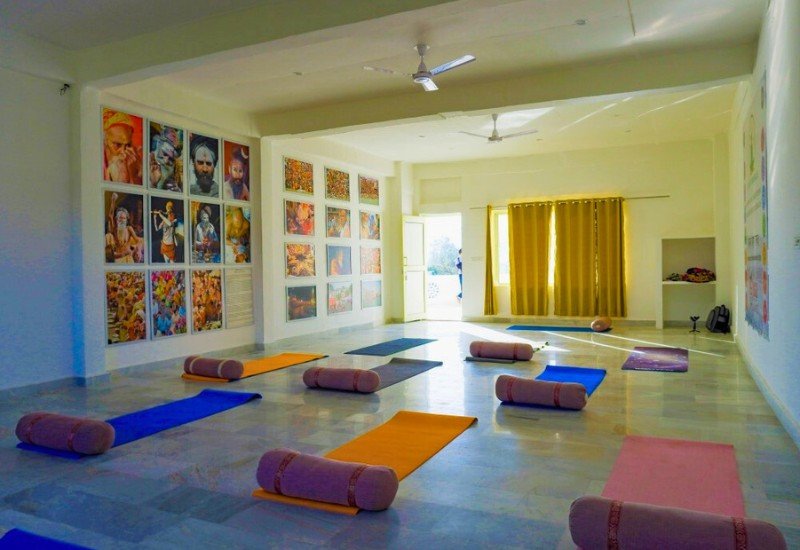



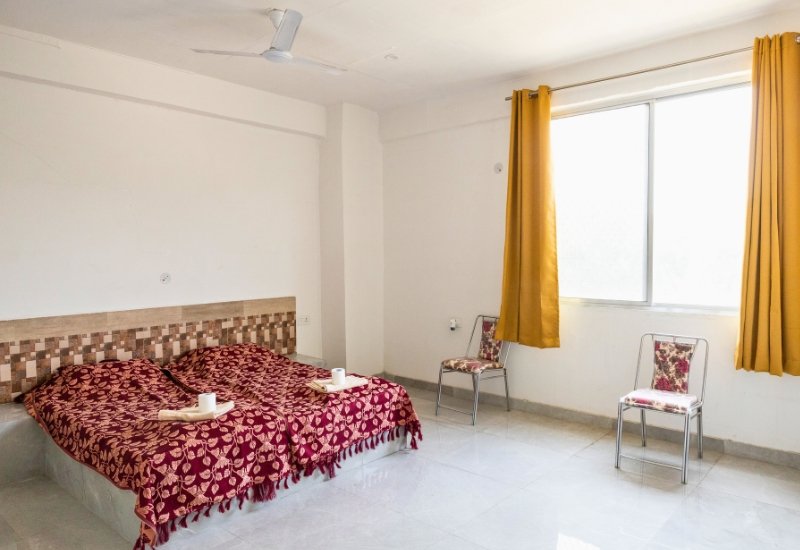
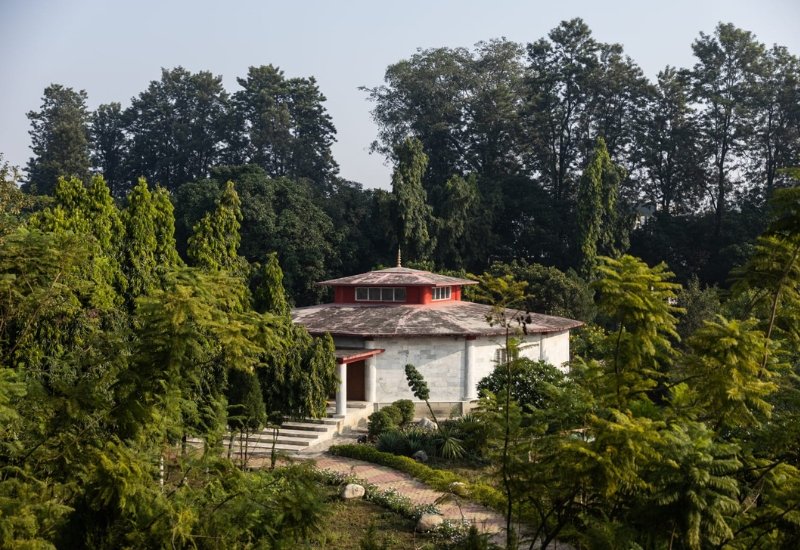
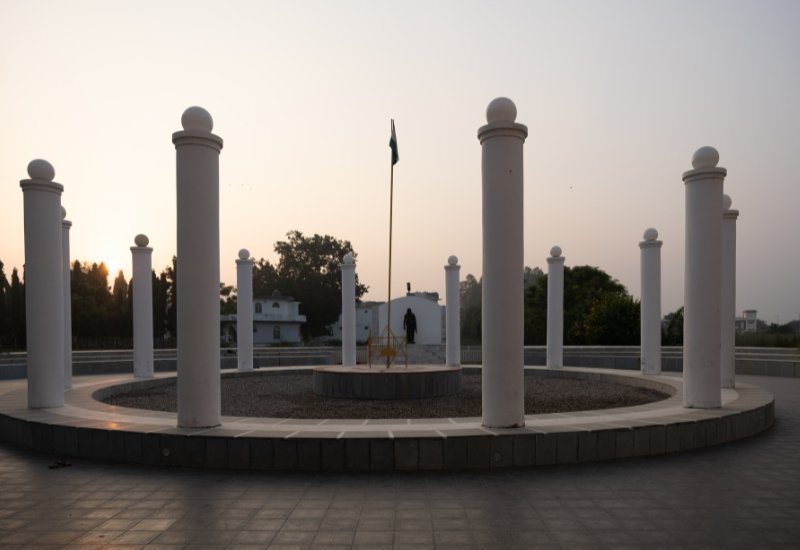









Yogic Meals at Atharv Yogshala
Atharv Yogshala offers three times a day freshly cooked meals, herbal tea and filtered drinking water. Atharv Yogshala Sattvic diet primarily consumes nutritious foods, including fresh produce and nuts, which is why this diet may lead to a number of health benefits. However, it’s quite restrictive, and many healthy foods are off-limits.
Living a healthy lifestyle is the expectation of everyone but very few obey the rule of living a healthy life. Eating Satvic food will give you good health, good nutrition and improves digestion. Sattvic food is very natural since it includes all fresh and medicinal ingredients. The diet is so natural that you don’t feel heavy or lethargic after eating and gives a peaceful feeling so here in Atharv Yogshala yoga practitioners slowly start incorporating Satvic food in theirs diet and learn to cook varieties of tasty dishes because this is going to show wonderful results in your body starting from good health, good energy boost and positive state of mind.
